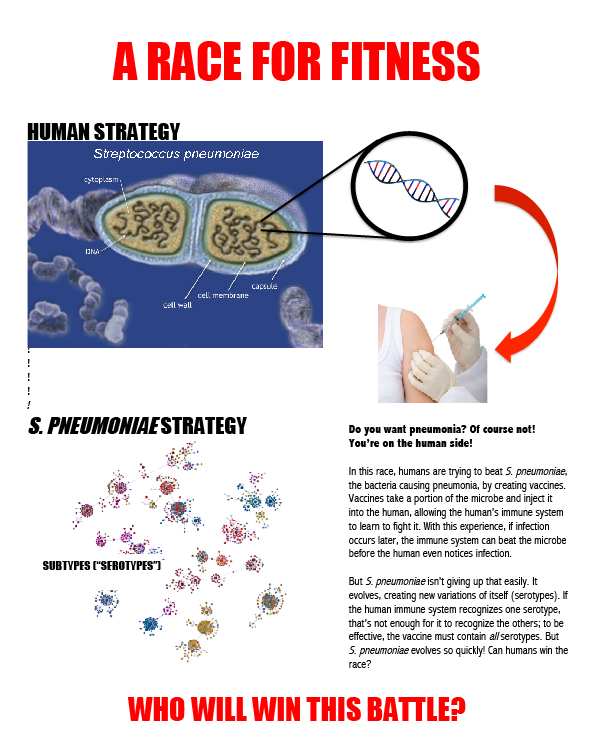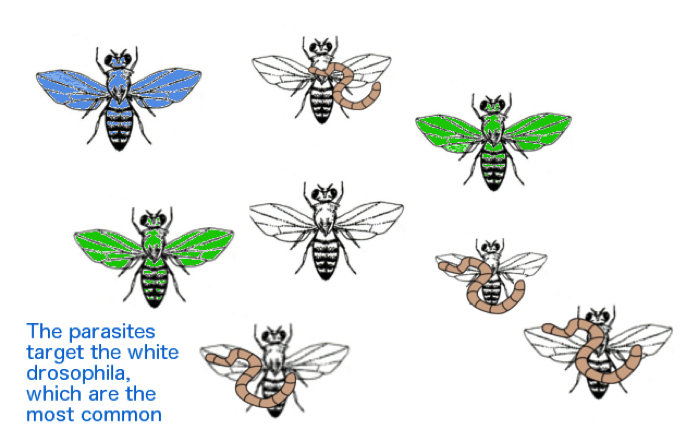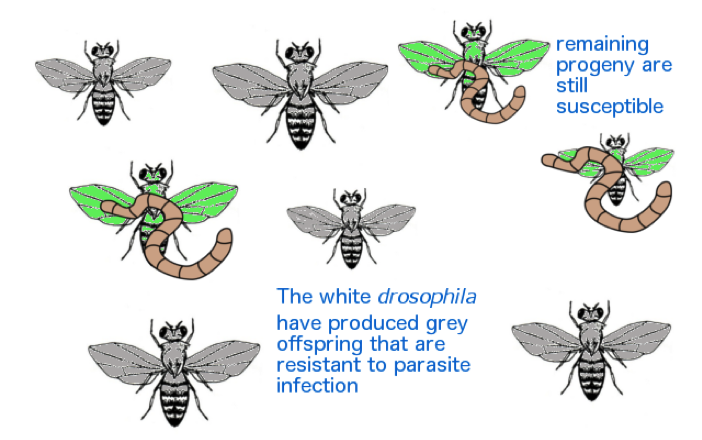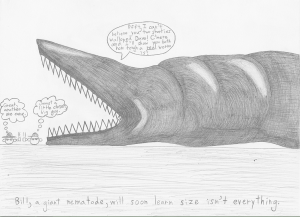Contributed by: Maria Berce, Danny Kang, Travise Kinney, Fariah Majid, & Alex Zachowski
Have you ever wondered why certain diseases are maintained in the human population if they are a threat to human health? It turns out that in some situations, a particular trait, potentially even a disease, may help an individual survive and thus can be maintained in a population over time.
Most laypeople believe that mental health illnesses occur when an individual carries a trait that is detrimental to humans. However, in reality, a trait can become a disorder when something that allows an individual to thrive in one environment becomes an obstacle in a different environment. For example, think about our ancestors who were hunters and gatherers. In their environment, being hyper-aware of their surroundings was beneficial because it protected them from attacks by predators. But what if this hyper-awareness was passed down to their offspring and was maintained generation after generation? Now, in our modern environment, being hyper-aware while sitting at a desk for hours on end each day would not lead to “productive” behavior. Thus, the trait of being hyper-aware may now perceived as an illness, specifically Attention-Deficit Hyperactivity Disorder (ADHD).
This animation illustrates the misconception that unfavorable traits are always selected against.
Just because a trait is maintained in a population does not mean it is favored by natural selection. Take a look below and see if you can now understand the incidence and progression of mental health illnesses through an evolutionary lens.
Attention-Deficit Hyperactivity Disorder (ADHD). There have been a lot of articles in the media lately about the sharp rise in the number of children in the U.S. and other western nations who are being diagnosed with ADHD. The U.S. government’s Center for Disease Control, or CDC, found that over 11% of children between the ages of four and 17 were diagnosed with ADHD in 2011, and that the rates of diagnosis have been growing by an average of three percent each year from 1997 to 2006. There is some disagreement over whether some of this increase is due to an over-diagnosis of the condition; however, the fact remains that ADHD is widespread and increasing. According to the CDC, children must have six or more symptoms of inattention and six or more symptoms of hyperactivity and impulsivity in order to be classified as ADHD. It is easy to see how these symptoms could make any child’s life a lot more difficult.
But another way of looking at ADHD has recently gained a following in the scientific community. Rather than looking at ADHD as a disorder, researchers have begun to look at it from the perspective of human evolution. In an article published in Journal of the American Academy of Child and Adolescent Psychiatry in 1997, Jensen and others hypothesized that ADHD is “an adaptation that reflects the optimization of brain function to some environments at the cost of poorer response to the demands of other environments.” In plain English, these scientists hypothesize that some children are genetically programmed to behave in a manner that may be disruptive in an academic or social setting.
Thomas Hartmann, a popular author and radio talk show host, wrote an entire book on this subject, titled “The Edison Gene: ADHD and the Gift of the Hunter Child.” In this book, Hartmann points out that Thomas Edison was expelled from school in the third grade for behavior that today would be labeled as symptomatic of ADHD. In his book, Hartmann argues that individuals with ADHD possess traits that were useful to humans during hunter-gatherer times and now individuals with these same traits are hardwired to be successful innovators, entrepreneurs, explorers, and inventors. Hartmann insists that these people shouldn’t be seen as “disordered” but as vital to our society and its progress, and calls for new alternative education methods for children with ADHD.
Interestingly, what was at once useful in protecting oneself from predators may now be valuable in a crime-infested neighborhood, for example. These scientists see hyper vigilance of one’s surroundings, hyperactivity that leads to an in-depth exploration of those surroundings, and fast response to stimuli – what others might label impulsivity – as “benefits” given the right environment.
Post-Traumatic Stress Disorder (PTSD). Post-traumatic stress disorder is a complex mental health condition that severely impacts the lives of those affected. Occurring after some sort of trauma, symptoms of PTSD include flashbacks, nightmares, and anxiety. According to PTSD United, a charity that provides support to sufferers, over 70% of adults in the United States will experience a trauma over the course of their lifetime, but only 1 in 5 of those people will go on to experience symptoms of PTSD. So why do some people get PTSD and not others?
In a 2004 article published in Clinical Psychology Review, psychologist and sociologist Michael Christopher argues that behaviors associated with PTSD, such as hyper-awareness, replaying the event in one’s head, and maintaining emotional distance from others, are hallmark “adaptive behaviors” to extreme threats. In other words, people who go through a traumatic situation such as war or robbery at gunpoint are psychologically and biologically transformed by the experience, resulting in the behaviors that we refer to as PTSD. These behaviors, Christopher argues, would all be beneficial to avoiding a similar future danger if they did not become pathological. Thus, in a sense, debilitating PTSD is essentially an “over-adaptation” by the human organism to the need to avoid severe dangers that may re-occur.
Anxiety Disorders. According to the National Institute of Mental Health, about 40 million adults are affected by an anxiety-related disorder, and rates have increased for the past 50 to 70 years. Why are mental disorders such as anxiety persisting in our population? Evolutionary biologists believe that anxiety, also referred to as the fight-or-flight response, was beneficial to our early ancestors when avoiding predators. This response increases heart rate and blood flow to muscles, and prompts us to respond faster in the face of danger. Today, many of us live in relatively peaceful environments, where our mean of survival is typing on a computer for eight hours a day. Although a certain amount of anxiety is beneficial in this environment as well, genetic predisposition to an anxiety disorder, which was selected for as a result of the environment of our ancestors, accounts for the fight-or-flight response even when we are not faced with grave danger.
We see that the behaviors that characterize these health conditions can be beneficial in some environments but not in others. An environment can determine the extent to which behaviors are harmful to the individual, based on the set of traits expressed by that individual. Although traits that characterize ADHD, PTSD, or anxiety disorders may have been beneficial in other environments, like previous societies, natural selection cannot remove these traits just because the modern environment may not value them. Since there is often no direct fitness consequence to having these mental illnesses , individuals who are diagnosed still pass on their genes, allowing for the illnesses to persist in a population.
When asking members of the Emory University community about their perceptions of mental health disorders, the responses we get are very interesting, some of which acknowledge the ways in which traits that characterize mental illnesses can be beneficial in today’s environment.
https://www.youtube.com/watch?v=Qvl_sBI_6FY
For further information, please refer to the following publications:
Avishai-Eliner, S., Brunson, K.L., Sandman, C.A., & T.Z. Baram. 2002. Stressed-out, or in (utero)? Trends Neurosci. 10: 518-24.
Byars, S.G. 2010. Natural Selection in a Contemporary Human Population. Proceedings of the National Academy of Sciences of the United States of America 107: 1787-792.
Christopher, M. A Broader View of Trauma: A biopsychosocial- evolutionary view of the role of traumatic stress response in the emergence of pathology and or growth. Clinical Psychology Review 24.1: 75-98.
Draganski, B., Gaser, C., Busch, V., Schuierer, G., Bogdahn, U., & A. May. 2004. Neuroplasticity: Changes in Grey Matter Induced by Training. Nature.
Hartmann, T. The Edison Gene. Vermont: Park Street Press, 2003. Print.
Gonçalves, V., Andreazza, A., & J. Kennedy. 2014. Mitochondrial Dysfunction in Schizophrenia: An Evolutionary Perspective. Springer-Verlag Berlin Heidelberg.
Jensen, P., Mrazek, D., Knapp, P., Steinberg, L., Pfeffer, C., Schowalter, J., Shapiro, T. 1997. Evolution and Revolution in Child Psychiatry: ADHD as a Disorder of Adaptation. Journal of the American Academy of Child and Adolescent Psychiatry 36.12: 1672-1681.
Lee, Y., Yamaguchi, Y., & Y. Goto. Neurodevelopmental Plasticity in Pre- and Postnatal Environmental Interactions: Implications for Psychiatric Disorders from an Evolutionary Perspective. Neural Plasticity.
Platter, B.E. 2009. Evidence of Contemporary Modern Human Evolution Contained Within the Human Genome. Lethbridge Undergraduate Research Journal.
Twenge, J. 2000. The Age of Anxiety? Birth Cohort Change in Anxiety and Neuroticism, 1952-1993. Journal of Personality and Social Psychology.
Twenge, J. 2008. Generational differences in psychological traits and their impact on the workplace. Journal of Managerial Psychology.
Twenge, J. 2012. Generational Differences in Young Adults’ Life Goals, Concern for Others, and Civic Orientation, 1966–2009. Journal of Personality and Social Psychology.
Weinstock, M. 2008. The long-term behavioural consequences of prenatal stress. Neuroscience and Biobehavioral Reviews 32: 1073–1086.
Non-Journal Resources:
Centers for Disease Control and Prevention, 2015. Attention-Deficit/Hyperactivity Disorder (ADHD) Data and Statistics. Accessed December 1, 2015 (http://www.cdc.gov/ncbddd/adhd/data.html).
The Decline of Play and Rise in Children’s Mental Disorders. (n.d.). Retrieved from https://www.psychologytoday.com/blog/freedom-learn/201001/the-decline-play-and-rise-in-childrens-mental-disorders
Facts & Statistics | Anxiety and Depression Association of America, ADAA. (n.d.). Retrieved from http://www.adaa.org/about-adaa/press-room/facts-statistics
PTSD United, 2013. PTSD Statistics. Accessed December 1, 2015 (http://www.ptsdunited.org/ptsd-statistics-2/).








.jpg)
